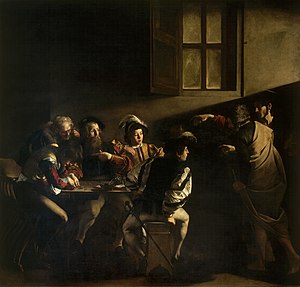Formation - The Supreme
Affirmation of Our Worth: The Wounds
“Every single person is worth all the blood of Christ.” (Christ is Passing By #81)
“Bring here thy finger
and see my hands…” (Jn. 20, 27).

The Mercy of Forgiving Thomas and Leading His Hand Into the Wound
St. Josemaria
Escriva: “How truly lovable is the
Sacred Humanity of our God! – You ‘entered’ into the most holy Wound of your
Lord’s right hand, and you asked me: ‘If one of Christ ‘s Wounds cleanses,
heals, soothes, strengthens and kindles and enraptures, what will the five not
do, open on the wood?’” (The Way #555).
“This point refers to a mystical
episode in the life of St. Josemaria, which he made anonymous in this text as
was his custom. …We have the precise documentation. It happened in Burgos on 6
June 1938. He was going to the Monastery of Las Huelgas, where he was
researching for his doctoral thesis. He was walking slowly, in the morning,
praying. This is what he noted telegraphically that night:
‘Monday, 6 June: My morning
prayer on my way to Huelgas guided by St. Joseph, with the light of the Holy
Spirit, I entered into the Wound of the right hand of my Lord.’”
This supernatural
event left him beset the whole day. When he wrote up his Notebook that nigh t,
he was still in the Wound of Christ:
‘Dear Juanito: This morning, on my way to las Huelgas, where
I went to do my prayer, I discovered a new world: the Most Holy Wound of our
Lord’s right hand. I was there all day long, kissing and adoring. How truly
lovable is the Sacred Humanity of our God! Pray that he give me that real love
of his and with it completely purify all my other affections. It’s not enough
to say, ‘Heart on the cross!’ Because if one of Christ’s wounds cleans, heals,
soothes, strengthens, enkindles, and enraptures, what will the five not do,
open on the wood? Heart on the cross! O my Jesus, what more could I ask for! I
realize that if I continue contemplating in this way (St. Joseph, my father and
lord, iis the one who led me there, after I asked him to enkindle me), I’ll end
up chalao, crazier than ever. Try it yourself! […]
Much love. From the Wound of the right hand, your Father
blesses you.
Mariano
The tradition of Christian piety, follow ing the great Saints, has
always ‘looked’ lovingly at the wounds of Christ and has ‘entered’ into them.
The bibliography on this subject is enormous. As so many Christian faithful
have done throughout the centuries, St. Josemaria recited each day after Mass,
the prayer En Ego: ‘As I reflect on
your five wounds and dwell upon them with deep compassion and grief’ he asked
Jesus: ‘in your wounds shelter me.’ The Author’s insistence that it was the
Wound of the right hand is
impressive. In this regard I copy a text of St. Teresa of Avila:
‘Appearing
to me as on former occasions, He began by showing me the wound in His left
hand, and then , with the other hand
drew out a large nail which was embedded in it, in such a way that in drawing
out the nail He seemed to me to be tearing the flesh. It was clear how very
painful this must be and I was sorely grieved by it.’[1]
The union and identification of St. Josemaria with Christ in the
mystery of the Cross leads him to this amazing expression: ‘Heart on the Cross!
Oh my Jesus, what more could I ask for ?’ To lose himself with Christ on the
Cross was, for him the greatest happiness. To understand this text, it seems
necessary to study it in parallel with The Way 163[2],
written in the Honduran Legation, and which has the same expression ‘Heart on
the Cross!’ These words and their spiritual context were obviously known to
Juan Jimenez Vargas, who also had been a refugee in the Honduran Legation with
St. Josemaria. There he would have
meditated on them. In the letter of June 6, there is an implicit dialogue with
Jimenez Vargas regarding the same point , with a strong ‘ascetical’
message that could be considered as
going ‘against- the-grain’ of the passions. But now, the Author has lived a
renewed experience of the sweetness of the Cross: to have the heart on the
Cross is not to ‘Crucify him,’ but to enter in to the joy of Christ. It is like
saying to Jimenez Vargas, the young medical lieutenant who will read the letter
on the Teruel front, that this ‘Hea r t on the Cross!’ ?#163 in the whole Cross
of Christ, is the summit of ‘mysticism,’ the total joy in Christ” ‘My
Jesus, what else could I wish!’ It is
the pure gif t of God. The purification of the heart, to which he aspire d in #
163, is not pure consequence
The practice of entering in to the wounds of Christ had a long history for Josemaria Escriva. The consideration that leads to #288 comes from January 1934. And from July of that year stems his desire to fulfill the ‘old’ resolution of entering each day ‘into the Wound of the Side of my Lord.’ The contemplation of the Wounds of Jesus occupied an important role in the life of prayer within the pathway towards sanctity which the Author taught.”[3]
After receiving mercy imaged in the wounds of Christ, pace the vacilating faith of the apostles, Christ continees to choose them and sends them forth. That is, "having had mercy, he chooses to send them forth in his even greater mercy: Miserandi atque Eligendi: The Vocation of Matthew, and of each one of us:

No comments:
Post a Comment